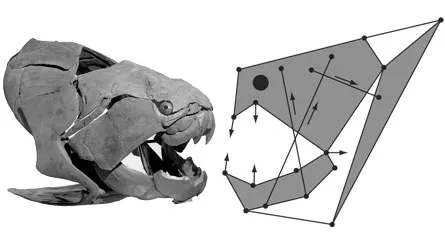Ancient fish with killer bite
Dunkleosteus clamped down on prey with three-quarters-of-a-ton force
An ancient, 1-metric-ton fish nearly as long as a school bus had a bite more powerful than nearly everything alive today, a new study reveals.

The 10-meter-long Dunkleosteus terrelli cruised Devonian seas about 360 million years ago, says Philip Anderson, a vertebrate paleontologist at the University of Bristol in England. Dunkleosteus sported bony armor on its head and the front part of its body, but the anatomy of its skull was even more unusual: When the creature opened its mouth, it simultaneously lifted its upper jaw and dropped its lower jaw. Most creatures just drop the lower jaw.
Anderson and colleague Mark Westneat of Chicago’s Field Museum analyzed five relatively complete Dunkleosteus fossils and noted the position of 33 landmarks, such as muscle attachments, on each specimen’s skull and jaws. Then, the researchers developed a computer model that allowed them to estimate the forces generated when a Dunkleosteus clamped down on its prey.
As Dunkleosteus slammed its jaws shut, the fanglike projections at the front of the creature’s mouth exerted a force of 6,170 newtons, the researchers report in the spring Paleobiology. At the rear of the bladelike jaws, bite forces approached 7,495 newtons, about three-quarters of a ton or half the weight of a VW Beetle.
Among modern animals, only the great white shark and some alligators have a stronger bite force, Anderson says. Although Dunkleosteus may have been the clamp-down champ of its era, the fish generated only about half the bite force of the dinosaur Tyrannosaurus rex, he notes.







